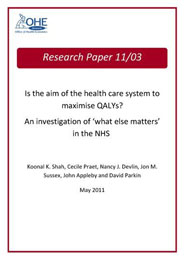Unlocking the Value of Combination Therapies

The appraisal of health care technologies by the UK’s National Institute for Health and Clinical Excellent (NICE) focuses on cost effectiveness, usually measured in terms of incremental cost per quality adjusted life year (QALY) gained. According to the findings presented in this Research…
The appraisal of health care technologies by the UK’s National Institute for Health and Clinical Excellent (NICE) focuses on cost effectiveness, usually measured in terms of incremental cost per quality adjusted life year (QALY) gained. According to the findings presented in this Research Paper, however, cost effectiveness does not appear to be the dominant consideration in NHS decisions about resource allocation.
In this paper, the authors examine what factors affect NHS decisions by analysing 51 Impact Assessments (IAs) completed by the UK Department of Health (DH) in 2008-9. Of the 51 IAs available, only eight used QALYs to evaluate benefits, including four of those associated with the largest monetised benefits. Ninety-three other unique benefits were applied in making NHS decisions. Most could be grouped into the following categories: improvement in health outcomes (26 of the 51), improvements in health service cost and efficiency (19), improvements in quality (15), and enhancing the patient and carer experience (11). For 21 IAs, no monetary impact was estimated and the statement was made in the IA that benefits could not be monetised or quantified.
Setting aside the issue of what cost and benefit perspective is ‘appropriate’, the authors point out that this research suggests that the perspectives of NICE and the DH are ‘very different’ with ‘clear implications’ for efficiency across the health care system.
A revised version of this paper has been published in Journal of Health Services Research & Policy and can be downloaded from: http://hsr.sagepub.com/content/17/3/157.long
Please cite as: Shah, K., Praet, C., Devlin, N., Sussex, J., Appleby, J. and Parkin, D., 2012. Is the aim of the English health care system to maximize QALYs? Journal of Health Services Research & Policy, 17(3), pp.157-163.
Is the Aim of the Health Care System to Maximise QALYs? An Investigation of
Shah, K., Praet, C., Devlin, N., Sussex, J., Appleby, J. and Parkin, D.
(2011) Is the Aim of the Health Care System to Maximise QALYs? An Investigation of. OHE Grant-Funded Research. Available from https://www.ohe.org/publications/aim-health-care-system-maximise-qalys-investigation/